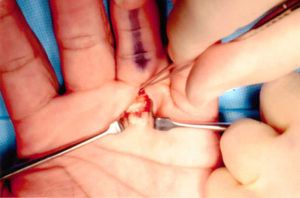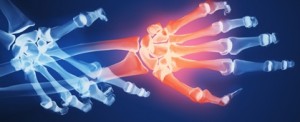Trigger finger surgery may be
recommended by your doctor
Trigger finger surgery may be recommended if non-surgical forms of treatment do not relieve the symptoms. .
 This type of surgery is performed as an outpatient, usually with simple local anesthesia.
This type of surgery is performed as an outpatient, usually with simple local anesthesia.
The following trigger finger surgery video shows a member of the American Society for Surgery of the Hand (www.assh.org), taking you through actual surgery. The procedure is described as it is being performed and, provides insight into the anatomy and causation of trigger finger.
The surgeon will ask the patient to lie down on a table on their back, with their hand stretch down at their side. The hand is properly cleaned and draped with sterile covers.
Doctor then makes an incision
The doctor makes an incision, usually no more than 1-cm long, at the bottom or base of the finger. Separating the skin, the doctor views the tendon sheath and pulleys that enable bending and extension of the affected finger.
The doctor identifies the proper pulley in the affected finger and incises or slices through it, thereby relieving the construction and giving the tendon more freedom of movement. The patient is usually asked to perform several movements with a finger to ensure proper range of motion, flexion and extension potential. Two to three stitches is usually all that are needed to close the incision, which may be absorbed or removed within 10 days to two weeks.
Video: Trigger Finger Surgery
==>Click HERE for information on Treating your Trigger Finger<==
The goal of trigger finger surgery
The goal is to open the pulley at the base of the finger so that the tendon can glide more freely. Active motion of the finger generally begins immediately after surgery and, normal use of the hand can usually be resumed once comfort permits. Some patients may feel tenderness, discomfort, and swelling about the area of their surgery longer than others. Occasionally, hand therapy is required after trigger finger surgery to regain better use.
Trigger finger surgery provides permanent relief from locking and triggering in the great majority of patients.
Surgical repair of trigger finger involves releasing the A1 pulley by cutting the fibers with a needle through the skin or by making an incision with a scalpel.
Trigger finger pain after trigger finger surgery
Post-operative pain is a normal side effect of any surgical procedure but the pain usually subsides in a few days after surgery. Some patients benefit by elevating the hand after surgery to reduce the pain and swelling, according to the American Academy of Orthopaedic Surgeons.
Residual Clicking or Triggering:
Residual clicking or triggering can occur if there is an incomplete release of the A1 pulley, previous scar tissue, or if post-operative scarring or adhesions form causes residual clicking.
Surgeons check the function of the finger intra-operatively to ensure an adequate release of the A1 pulley and a resolution of the symptoms. Adhesions or scarring forms if patients do not begin early range of motion exercises of the finger. This would decrease the risk of adhesions able to cause residual clicking or triggering.
Trigger finger surgery Infection:
Infection is a risk of any surgery. The risk of infection from trigger finger surgery is very low, but remains a risk.. It is advised to keep the surgical site clean and, to not remove the operative dressing until the followup appointment. The hand surgeon performing the procedure will discuss specifics in regards to how to care for the wound.
Trigger finger surgery has a high success rate:
Many patients can actually move their hands and fingers right after the surgery. However, trigger finger surgery can’t guarantee 100% cure. Still, compared to non-surgical treatments, trigger finger surgery offers the best results.
But although that’s the case, surgery must be carefully considered as an option. A consultation with a doctor must take place before deciding to have a surgery. In some other cases, non-surgical treatments are enough to address trigger finger. But when the symptoms have become too disruptive and severe, trigger finger surgery is called for.
Remember
Always verify the training, education and certification of any surgeon, and make sure he or she belongs to a reputable Orthopedic or Plastic Surgery organization or association before undertaking trigger finger surgery.
American Academy of Orthopaedic Surgeons
Best Selling Trigger Finger Splints on Amazon
==>Click HERE for information on Treating your Trigger Finger<==
Trigger Finger Surgery FAQ’s
Initially, there may be some pain or soreness. Your Doctor may recommend over-the-counter painkillers for relief. You should be gentle with movements at first, but full movement can be expected to return in 1 to 2 weeks. Your doctor will take out your stitches 1 to 2 weeks after surgery. Then it will probably take about 6 weeks for your finger to heal completely. During Trigger Finger Surgery you will be done while you are awake. The doctor will give you a shot (injection) to numb your hand and prevent pain. Potential complications of trigger finger surgery include tenderness over the site of the incision. This occurs quite frequently but it usually settles down on its own. the success rate is over 90%. The tendon sheath that's cut during surgery grows back together more loosely so the tendon has more room to move. Sometimes people need more than one surgery. But trigger finger only recurs in about 3 percent of people after either open surgery or percutaneous release.Is trigger finger surgery painful?
How long do stitches stay in after trigger finger surgery?
Am I awake during trigger finger surgery?
Can anything go wrong with trigger finger surgery?
What is the success rate of trigger finger surgery?
Can trigger finger come back after surgery?
As an Amazon Affiliate I earn from qualifying purchases. TriggerFingerSymptoms.com is a participant in the Amazon Services LLC Associates Program, an affiliate advertising program designed to provide a means for sites to earn advertising fees by advertising and linking to Amazon.com,
Links on this trigger finger surgery page are sponsored affiliate links and the owner makes commission if you buy after clicking these links. The owner is not a bona-fide user of this product. However, he has thoroughly researched it and provided a personal opinion only. This disclosure is in accordance with the Federal Trade Commission’s 16 CFR, Part 255: “Guides Concerning the Use of Endorsements and Testimonials in Advertising.”





